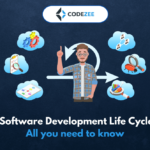Find out the information you require to decide which approach is best for
Looking to give your software development workflow more structure? The right software development methodology for your product organisation will largely depend on the size of your team, your objectives, and other elements. Here is a summary of the most popular and well-known software development methodologies to assist you in selecting the best option for your team.
1. Waterfall
Waterfall software development is the most conventional and orderly option available. Although Waterfall is typically considered to be an "old school" or outdated methodology, understanding its history and structure can help you appreciate the adaptability of more modern methodologies. Waterfall, which was first developed in 1970, was one of the most well-known methodologies for many years due to its plan-driven methodology.
A waterfall requires a lot of upfront structure and documentation. It is broken down into discrete phases or steps. The first stage is crucial because it calls for a thorough understanding of the project's requirements and scope by both developers and clients before anything else is done. Determine the project's requirements and scope, analyse those requirements, design, implement, test, deploy, and then maintain are some of the relatively rigid stages that frequently go in this order.
The Waterfall method typically necessitates a complete restart should any changes or errors that were made in the later stages need to be corrected. It is customary for one stage to be completed before the next can start, which can facilitate organisation and assignments. And since the project's full scope is known in advance, software progress can be easily tracked.
2. Feature-Driven Development
Feature-Driven Development (FDD), a method for implementing the Agile methodology, is an iterative and incremental approach to software development. FDD is frequently seen as an older methodology, somewhat of a forerunner to contemporary Lean/Agile implementations, similar to how Waterfall is. FDD is particularly client-centric and maintains a focus on the objective of delivering working software frequently, making it a good fit for smaller development teams.
The first step in FDD's five-step process for producing tangible software is to create an overall model. Create a list of features next, then make plans based on each feature. The most work will be put into the final two steps, design by feature and build by feature. Status reporting is encouraged at every stage and aids in keeping track of the progress, outcomes, and potential mistakes.
A thorough understanding of the client's requirements and the overall model at the start of the project can minimise any surprises during development, even though FDD's ability to adapt quickly is one of its stronger qualities.
3. Agile
Growing dissatisfaction with Waterfall and other rigid, highly structured methodologies led to the creation of the Agile methodology. This method is created to accommodate change and the requirement for quicker software production.
Agile emphasises customer collaboration throughout the development process, responds to change instead of adhering to a predetermined plan, values people and their relationships and interactions over tools, values presenting working software over documentation, and values people over tools.
With the Agile methodology, teams work on projects in brief sprints or iterations, each of which has a set duration and a set of deliverables that are not necessarily completed in that order. Teams strive to deliver functioning software during sprints (or some other tangible, testable output).
Agile places a strong emphasis on teamwork and collaboration, as well as internal feedback from various departments and clients. The Agile approach places the highest priority on client satisfaction, which teams attain by consistently delivering functional, tested, and prioritised features.
4. Scrum
Scrum is a different way to apply the agile methodology, but it takes its guiding principles—that teams and developers should work closely and frequently—from agile.
With Scrum, software is developed iteratively with the team at the centre; experienced and disciplined team members on smaller teams may succeed with this approach the most because it necessitates self-organization and self-management.
5. Extreme Programming (XP)
Extreme Programming, or XP, is another Agile framework that focuses on using best practises in software development to create higher quality software. Like the majority of Agile methodologies, XP permits frequent releases in condensed development sprints that encourage change as necessary.
Generally speaking, XP adheres to a set of values rather than a set of steps, including respect, communication (teams must cooperate and work together on every piece of software), consistency in feedback, and simplicity (develop only what is necessary, nothing more).
Extreme Programming mandates that developers first plan and comprehend the user stories—the informal descriptions of specific features—provided by the client. Iterative work processes and scheduling are other techniques. Simple designs, frequent testing, and coding all contribute to the development of software that is error-free. Following more testing, pay attention to feedback to better understand functionality.
6. Lean
Lean integrates practises and principles from the manufacturing sector and broadly applies them to a variety of industries, including software development. It is both a workflow methodology and a mindset. Although Agile is a great methodology for the practical application of development best practises, it lacks guidelines for scaling these practises across the organisation or using them in situations other than development-type work.
Lean's fundamental tenets—optimize the whole, eliminate waste, build quality into everything you do, create knowledge, defer commitment, deliver results quickly, and respect people—can help to direct organisational decision-making in a way that can uncover potential problems and uphold a positive organisational culture.








Comment